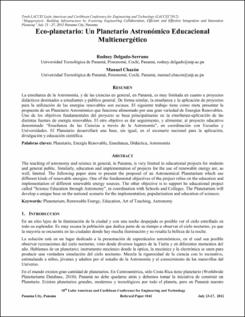Mostrar el registro sencillo del ítem
The evolution of the observed Hubble sequence over the past 6GYR
| dc.contributor.author | Delgado, Rodney | |
| dc.contributor.author | Hammer, Francois | |
| dc.contributor.author | Yang, Yan Bin | |
| dc.contributor.author | Puech, Mathieu | |
| dc.contributor.author | Flores, Héctor | |
| dc.contributor.author | Rodrígues, Myriam | |
| dc.date.accessioned | 2017-08-24T20:19:48Z | |
| dc.date.accessioned | 2017-08-24T20:19:48Z | |
| dc.date.available | 2017-08-24T20:19:48Z | |
| dc.date.available | 2017-08-24T20:19:48Z | |
| dc.date.issued | 2010-11-01 | |
| dc.date.issued | 2010-11-01 | |
| dc.identifier.uri | http://ridda2.utp.ac.pa/handle/123456789/2882 | |
| dc.identifier.uri | http://ridda2.utp.ac.pa/handle/123456789/2882 | |
| dc.description | During the past years we have confronted serious problems of methodology concerning the morphological and kinematic classification of distant galaxies. This has forced us to create a new simple and effective morphological classification methodology, in order to guarantee a morpho-kinematic correlation, make the reproducibility easier and restrict the classification subjectivity. Giving the characteristic of our morphological classification, we have thus been able to apply the same methodology, using equivalent observations, to representative samples of local and distant galaxies. It has allowed us to derive, for the first time, the distant Hubble sequence (_6 Gyr ago), and determine a morphological evolution of galaxies over the past 6 Gyr. Our results strongly suggest that more than half of the present-day spirals had peculiar morphologies, 6 Gyr ago. | en_US |
| dc.description.abstract | During the past years we have confronted serious problems of methodology concerning the morphological and kinematic classification of distant galaxies. This has forced us to create a new simple and effective morphological classification methodology, in order to guarantee a morpho-kinematic correlation, make the reproducibility easier and restrict the classification subjectivity. Giving the characteristic of our morphological classification, we have thus been able to apply the same methodology, using equivalent observations, to representative samples of local and distant galaxies. It has allowed us to derive, for the first time, the distant Hubble sequence (_6 Gyr ago), and determine a morphological evolution of galaxies over the past 6 Gyr. Our results strongly suggest that more than half of the present-day spirals had peculiar morphologies, 6 Gyr ago. | en_US |
| dc.language | eng | |
| dc.language.iso | eng | en_US |
| dc.rights | https://creativecommons.org/licenses/by-nc-sa/4.0/ | |
| dc.rights | info:eu-repo/semantics/openAccess | |
| dc.subject | galaxies | en_US |
| dc.subject | evolution-galaxies | en_US |
| dc.subject | formation-galaxies | en_US |
| dc.subject | peculiar-galaxies | en_US |
| dc.subject | spiralgalaxies | en_US |
| dc.subject | statistics methods | en_US |
| dc.subject | data analysis | en_US |
| dc.subject | galaxies | |
| dc.subject | evolution-galaxies | |
| dc.subject | formation-galaxies | |
| dc.subject | peculiar-galaxies | |
| dc.subject | spiralgalaxies | |
| dc.subject | statistics methods | |
| dc.subject | data analysis | |
| dc.title | The evolution of the observed Hubble sequence over the past 6GYR | en_US |
| dc.type | info:eu-repo/semantics/article | |
| dc.type | info:eu-repo/semantics/publishedVersion |
